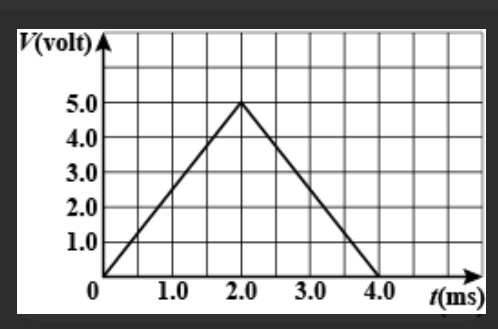
The potential difference across a $150 \mathrm{mH}$ inductor as a function of time is shown in figure. Assume that the initial value of the current in the inductor is zero. What is the current when $t=4.0 \mathrm{ms} ?$

(A) $2.67 \times 10^{-4} \mathrm{A}$
(B) $3.67 \times 10^{-2} \mathrm{A}$
(C) $6.67 \times 10^{-2} \mathrm{A}$
(D) $9.67 \times 10^{-4} \mathrm{A}$
Answer
138.9k+ views
Hint: The electric potential difference between points A and B, VB−VA, is defined to be the change in potential energy of a charge q moved from A to B, divided by the charge. Units of potential difference are joules per coulomb, given the name volt (V) after Alessandro Volta. When a voltage is connected across a wire, an electric field is produced in the wire. Metal wire is a conductor. Some electrons around the metal atoms are free to move from atom to atom. This causes a difference in energy across the component, which is known as an electrical potential difference.
Complete step by step answer
If the electric potential difference between two locations is 1 volt, then one Coulomb of charge will gain 1 joule of potential energy when moved between those two locations. Because electric potential difference is expressed in units of volts, it is sometimes referred to as the voltage.
$\mathrm{V}_{\mathrm{L}}=\mathrm{L} \dfrac{\mathrm{d}}{\mathrm{dt}}$
$\therefore \quad \mathrm{di}=\dfrac{1}{\mathrm{L}}\left(\mathrm{V}_{\mathrm{L}} \mathrm{dt}\right)$
$\therefore \quad \int \mathrm{di}=\mathrm{i}=\dfrac{1}{\mathrm{L}} \int \mathrm{V}_{\mathrm{L}} \mathrm{dt} \quad$ or $\quad \mathrm{i}=\dfrac{1}{\mathrm{L}}$
At $\mathrm{t}=4 \mathrm{ms}$
$\mathrm{i}=\left(150 \times 10^{-3}\right)^{-1}\left(\dfrac{1}{2} \times 4 \times 10^{-3} \times 5\right)=6.67 \times 10^{-2} \mathrm{A}$
So the correct answer is option C.
Note: One volt is defined as the difference in electric potential between two points of a conducting wire when an electric current of one ampere dissipates one watt of power between those points. Voltage, also sometimes called potential difference or electromotive force (EMF), refers to the amount of potential energy the electrons have in an object or circuit. In some ways, you can think of this as the amount of "push" the electrons are making to try to get towards a positive charge. This process defines the electric potential of a point-like charge. Therefore, a system consisting of a negative and a positive point-like charge has a negative potential energy.
Complete step by step answer
If the electric potential difference between two locations is 1 volt, then one Coulomb of charge will gain 1 joule of potential energy when moved between those two locations. Because electric potential difference is expressed in units of volts, it is sometimes referred to as the voltage.
$\mathrm{V}_{\mathrm{L}}=\mathrm{L} \dfrac{\mathrm{d}}{\mathrm{dt}}$
$\therefore \quad \mathrm{di}=\dfrac{1}{\mathrm{L}}\left(\mathrm{V}_{\mathrm{L}} \mathrm{dt}\right)$
$\therefore \quad \int \mathrm{di}=\mathrm{i}=\dfrac{1}{\mathrm{L}} \int \mathrm{V}_{\mathrm{L}} \mathrm{dt} \quad$ or $\quad \mathrm{i}=\dfrac{1}{\mathrm{L}}$
At $\mathrm{t}=4 \mathrm{ms}$
$\mathrm{i}=\left(150 \times 10^{-3}\right)^{-1}\left(\dfrac{1}{2} \times 4 \times 10^{-3} \times 5\right)=6.67 \times 10^{-2} \mathrm{A}$
So the correct answer is option C.
Note: One volt is defined as the difference in electric potential between two points of a conducting wire when an electric current of one ampere dissipates one watt of power between those points. Voltage, also sometimes called potential difference or electromotive force (EMF), refers to the amount of potential energy the electrons have in an object or circuit. In some ways, you can think of this as the amount of "push" the electrons are making to try to get towards a positive charge. This process defines the electric potential of a point-like charge. Therefore, a system consisting of a negative and a positive point-like charge has a negative potential energy.
Recently Updated Pages
Young's Double Slit Experiment Step by Step Derivation

How to find Oxidation Number - Important Concepts for JEE

How Electromagnetic Waves are Formed - Important Concepts for JEE

Electrical Resistance - Important Concepts and Tips for JEE

Average Atomic Mass - Important Concepts and Tips for JEE

Chemical Equation - Important Concepts and Tips for JEE

Trending doubts
JEE Main 2025 Session 2: Application Form (Out), Exam Dates (Released), Eligibility, & More

JEE Main 2025: Derivation of Equation of Trajectory in Physics

Learn About Angle Of Deviation In Prism: JEE Main Physics 2025

Electric Field Due to Uniformly Charged Ring for JEE Main 2025 - Formula and Derivation

JEE Main 2025: Conversion of Galvanometer Into Ammeter And Voltmeter in Physics

Degree of Dissociation and Its Formula With Solved Example for JEE

Other Pages
JEE Advanced Marks vs Ranks 2025: Understanding Category-wise Qualifying Marks and Previous Year Cut-offs

Electric field due to uniformly charged sphere class 12 physics JEE_Main

Physics Average Value and RMS Value JEE Main 2025

Dual Nature of Radiation and Matter Class 12 Notes: CBSE Physics Chapter 11

Formula for number of images formed by two plane mirrors class 12 physics JEE_Main

Displacement-Time Graph and Velocity-Time Graph for JEE




